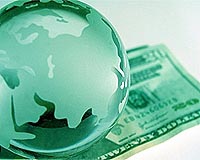| . |  |
. |
London (AFP) May 26, 2009 US Energy Secretary Steven Chu said Tuesday the Obama administration wanted to paint roofs an energy-reflecting white, as he took part in a climate change symposium in London. The Nobel laureate in physics called for a "new revolution" in energy generation to cut greenhouse gas emissions. But he warned there was no silver bullet for tackling climate change, and said a range of measures should be introduced, including painting flat roofs white. Making roads and roofs a paler colour could have the equivalent effect of taking every car in the world off the road for 11 years, Chu said. It was a geo-engineering scheme that was "completely benign" and would keep buildings cooler and reduce energy use from air conditioning, as well as reflecting sunlight back away from the Earth. For people who found white hard on the eye, scientists had also developed "cool colours" which looked to the human eye like normal ones, but reflect heat like pale colours even if they are darker shades. And painting cars in cool or light colours could deliver considerable savings on energy use for air conditioning units, he said. Speaking at the start of a symposium on climate change hosted by the Prince of Wales and attended by more than 20 Nobel laureates, Chu said fresh thinking was required to cut the amount of carbon created by power generation. He said: "The industrial revolution was a revolution in the use of energy. It offloaded from human and animal power into using fossil fuels. "We have to go to a different new revolution that can severely decrease the amount of carbon emissions in the generation of energy."
earlier related report Tetsuo Saito said Japan could meet the target through greater solar power development, cleaner cars and ecologically friendly homes. He said Japan could aim for a 25 percent cut if it factored in carbon trading, forest absorption of carbon dioxide and its contributions to developing countries. Prime Minister Taro Aso plans to announce Japan's so-called mid-term target in June ahead of a December meeting in Copenhagen set to hammer out a new climate treaty to replace the Kyoto Protocol when it expires in 2012. "How important is it to create a framework that includes China, the United States, India and other major emitters in order for us to protect the Earth?" said Saito in an interview with public broadcaster NHK. "Industrial nations including Japan need to present ambitious targets. I believe it is a good option for Japan to work toward a 15 percent reduction." By comparison, the European Union has said it would slash emissions by 20 percent of 1990 levels by 2020 and raise the target to 30 percent if others set similarly ambitious goals. Japan's government this month launched a public survey in which it proposed six options -- ranging from a four percent increase of emissions to a reduction of more than 25 percent. Over 45 percent of respondents backed a seven percent cut, 13.5 percent supported a 15 percent reduction, and 4.9 percent favoured a 25 percent cut. The survey also showed that 15.3 percent support a four percent increase in emission from 1990 levels -- the target also favoured by one of the country's three big industrial lobbies, the Japan Business Federation. For the longer term, Japan and the European Union agree that the global target should be a 50 percent emission cut by 2050, but they disagree on which year should be the base year to calculate the target. Japan argues that the resource-poor country has already achieved a highly energy-efficient lifestyle and industrial infrastructure, making it more expensive for Japan to slash emissions further. Share This Article With Planet Earth
Related Links Climate Science News - Modeling, Mitigation Adaptation
 Climate change: Progress seen on funding problem
Climate change: Progress seen on funding problemParis (AFP) May 26, 2009 The world's biggest carbon polluters made headway in talks here Tuesday on how to beef up funding to help poor countries in the firing line of climate change, senior officials said. The so-called Major Economies Forum (MEF) advanced on one of the key issues troubling negotiations for a new global treaty due to be crafted in Copenhagen in December, they said. "We made progress on a major ... read more |
|
| The content herein, unless otherwise known to be public domain, are Copyright 1995-2009 - SpaceDaily. AFP and UPI Wire Stories are copyright Agence France-Presse and United Press International. ESA Portal Reports are copyright European Space Agency. All NASA sourced material is public domain. Additional copyrights may apply in whole or part to other bona fide parties. Advertising does not imply endorsement,agreement or approval of any opinions, statements or information provided by SpaceDaily on any Web page published or hosted by SpaceDaily. Privacy Statement |